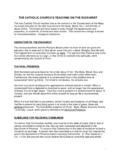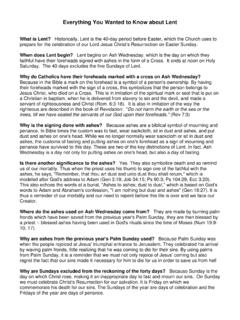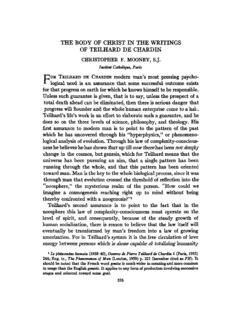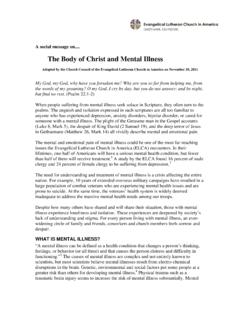Transcription of The Mystical Body of Christ - Father Peffley
1 The Mystical body of ChristAbide in me, and I in you. As the branch cannot bear fruit of itself unless it remain onthe vine, so neither can you unless you abide in me (Jn 15:4)A study of the Incarnation could not be complete without reflecting on the doctrine ofthe Mystical body of Christ . The Second Divine Person took flesh at one point in history,as we read in the first chapter of St. John: "And the Word was made flesh and dweltamong us" (Jn 1:14). Without the incarnation, there could be no Mystical body . The oneis the source, or prerequisite, for the other. The Mystical body exists because the Wordhas become man, and God has willed that the Mystical body be the extension, orprolongation, of the Incarnation and the Redemption.(1) The idea of Christ 's Mystical body is clearly seen in the gospels and in St. Paul.
2 Itwould be well to examine just a few of these passages in order to gain a foundation forunderstanding later writings of the Church Fathers, the Popes and of the most thought -provoking passages in the Gospels is that of Our Lord tellingabout the final judgement. Men will be separated one from another as a shepherdseparates sheep from goats. The Lord condemns those who did not give Him food whenHe was hungry, clothing when He naked, or a visit when He was sick. He tells thenations "In so far as you did this to one of the least of these brothers, you did it to me" (Mt25:40). Here Christ is identifying Himself with mankind a very real way. He says He ispresent in His brothers to such a degree that it is He who is fed, clothed and visited. Thisis a powerful statement, and it sheds light on our understanding of Christ 's Mystical Christ dwells in each individual person.
3 This is seen again in the Acts of theApostles where St. Paul hears the words of Christ , "Saul, Saul, why are you persecutingme?" (Acts 9:4-5). Paul had never known Our Lord personally. He was persecuting theChristians. Christ however stated that He Himself was being persecuted. Again, Christ isidentifying Himself with men. He is joined to them, a part of them, or rather they are apart of the priestly prayer of Christ in St. John's Gospel, Christ says, " Father , may they beone in us as you are in me and I am in me in them and you in me, may theybe so completely " (Jn. 17:21-23). Not only do we see here that Christ and theFather are one, but that Christ is in His disciples. In another passage Our Lord speaks tothe twelve: "Make your home in me, as I make mine in I am the vine and you arethe branches.
4 Whoever remains in me, with me in him, bears plenty of fruit" (Jn 15:4-5).The image of the vine and the branches points to a theme that is developed in St. Paul'swritings, namely, that Christ is the head, or source of His body , and we are the off from the vine, the branches have no event that occurred on the road to Damascus made a deep impression on , for his epistles are filled with the reality of the Mystical body . An example of this isseen when Paul writes on marriage:A man never hates his own body , but he feeds it and looks after it; and that is the wayChrist treats the Church, because it is his body and we are its living parts (Eph 5:30).We, who belong to the Church, are the living parts or members of Christ 's body ." Christ is the head of the Church and saves the whole body " (Eph 5:23). Just as Christ isthe vine, He is the head of His body , giving life to the members and bringing about theirsalvation.
5 Paul uses the analogy of the human body in showing that all parts mustcooperate for the good of the Church: "Not you together are Christ 's body ; but each ofyou is a different part of it" (I Cor 12:27). Some members are apostles, some teachers,but they all form one body united in point found in the epistles is that Christians are called by God to live theirlives "in ' Christ Jesus" (1 Cor 1:30). It is through baptism that this occurs, as we read inRomans: "Are you not aware that we who were baptized into Christ Jesus were baptizedinto His death?" (Rom. 6:3). Paul uses the phrases "in Christ Jesus" and "in Christ " overand over again in his epistles. He stresses that there is a real bond between the baptizedand Christ . Baptism is the means of incorporation into the body of should be stated that Paul does not use the word " Mystical " when describing thebody of Christ .
6 He simply refers to it as "His body ." " Mystical " was first officially used inBoniface VIlI's bull, Una Sanctam, in unfolding the ideas put forth by of the most important Pauline themes connecting with the Mystical body is thatAdam was a type of Christ . In Adam, the whole human race fell (I Cor 15:45). As Adamwas the first head of mankind, so Christ became the new Head of the entire human racethrough His victory over death and sin. When the Second Divine Person became man allof humanity was elevated. Christ , being both true God and true man manifested Hisposition as Head of the whole human race. And by founding his Church on the Apostlesand the Sacraments, He set up a means to incorporate people into His very life. TheChurch, then, is the extension of Christ in time, which reaches out to bring theRedemptive grace to all to St.
7 Paul, only the baptized faithful are members of Christ 's body . Thebaptized become one in Christ Jesus: "All baptized in Christ , you have all clothedyourselves in Christ , and there are no more distinction between Jew and Greek, slaveand free, male and female, but all of you are one in Christ Jesus" (Gal 3:27-28). Inanother passage, Paul says that it is through baptism and the Holy Spirit that we aresaved: It was for no reason except his own compassion that he saved us, by means of thecleansing water of rebirth and by renewing us with the Holy Spirit which he has sogenerously poured over us through Jesus Christ our Savior" (Titus 3:5-6). At baptism, thefaithful become sharers in the Divine Life of ideas and themes in Paul become 'the foundation for later studies in Church Fathers are the first to expound upon the Pauline writings and to bring outdeeper and more profound insights into the doctrine of the Mystical body .
8 In a letter tothe Church of Magnesia, St. Ignatius of Antioch refers to the Mystery of Christ 's body bytelling the faithful to have "a. union both according to the flesh and according to thespirit."(2) Not only do they have true fraternity among themselves as Christian brothers, butthey have a deeper union which comes from the Holy Spirit, Who is given to them inbaptism. Irenaeus also echoes the words of Paul by referring to the "great and gloriousBody of Christ ."(3) Here again, we see that the word " Mystical " is not used, even though the doctrinewas present in the early Church. For St. Paul and the Church Fathers, the extension ofChrist's body is a reality. According to Irenaeus, the body of Christ is what realizes thewill of the Father in men and renews them from their old way into the new life of Christ .(4) A Pauline theme which is developed by Irenaeus deals with Christ as the SecondAdam.
9 He writes: "We have offended God in the first but we are reconciledthrough the obedience even unto death of the Second Adam" (Adv. Haer. V, 16, 3.).Adam was the head of the human race and caused its fall from grace, but Christ , the newHead, redeemed all mankind and takes His place as the Head of the Mystical Cyprian also asserts the union of all faithful Christians in Christ , a union which isseen in the Church. He writes that. "The Church is one, with one head and one "(De Catholicae ecclesiae unitate, 5). This reminds us of Christ 's teaching that He is thevine for the branches, that is, the Head and origin of divine life. The writings of bring out a further understanding of the doctrine of the Mystical body . Hesays that through the Incarnation and the Redemptive act on Calvary, all men areintimately connected with Christ .
10 The whole human race is elevated and brought into agreater participation in the supernatural life. In his work against the Arians, Athanasiuswrites: "For just as the Word, having assumed a body , became man, so also, we menhave been assumed to the Word through the Flesh, and are made inheritors of eternallife and bearers of God through Him" (III Contra Arianos, 34).With the coming of St. Augustine, a great advance was made in theology. Ourunderstanding of the Mystical body was deepened by his insights and writings. Forexample, he said that "what the soul is to the body of a man, the Holy Spirit is to Christ 'sBody which is the Church."(5) This reaffirms the teachings of St. Paul that the Church, but he goes further tostate that the Holy Spirit is "the soul" of that body . Here Augustine is speakinganalogically.













